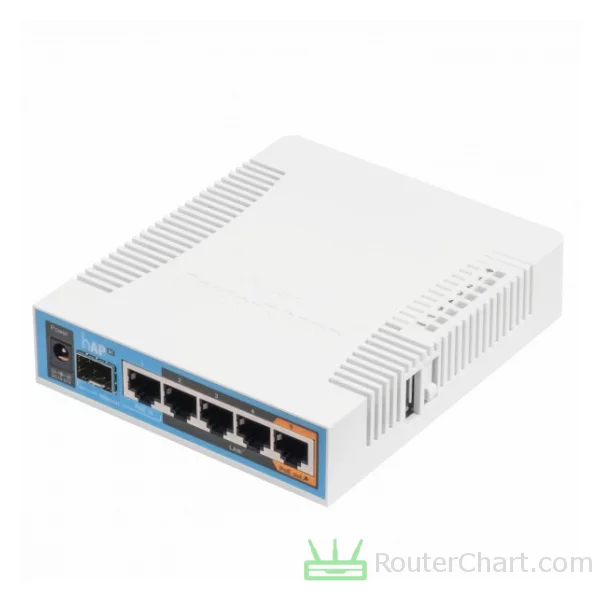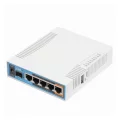MikroTik RouterBoard hAP AC review
MikroTik introduced the RouterBoard hAP AC router in 2016. It is powered by Qualcomm Atheros QCA9558 @ 720 MHz chipset, 128 MB of RAM, and 16 MB of flash memory.
Keen to discover if this MikroTik router lives up to the hype? Keep reading to find out!
Table of Contents
- MikroTik RouterBoard hAP AC specifications
- Body, dimensions, weight
- System, chipset, RAM, flash, power supply
- Network, protocols, WAN and LAN ports
- Wireless, antennas, speed, security
- Connectivity
- Features
- Administration, user interface, login information
- Links
- Verdict, Pros and Cons
- Photos
- Comparisons
Our personal experiences and opinions form the basis of this article. We aimed to share insights on a topic, and we hoped others would find it useful and inspirational. If you noticed any mistakes or missing details about the MikroTik RouterBoard hAP AC, please let us know.

The RouterBoard hAP AC is a popular router model from MikroTik, and many users have given it positive reviews. MikroTik is a well-respected manufacturer in the networking industry.
MikroTik RouterBoard hAP AC specifications
| Brand | MikroTik |
|---|---|
| Name | RouterBoard hAP AC |
| Type | RB962UiGS-5HacT2HnT |
| Rating | |
| Launch | 2016 |
Body
| Dimensions | 114 x 137 x 29 mm |
|---|
If you plan to move a lot and need to take your router with you, the size is important. Otherwise, the size isn't too crucial.
System
| Chipset | Qualcomm Atheros QCA9558 @ 720 MHz |
|---|---|
| RAM | 128 MB |
| Flash | 16 MB |
| OS | RouterOS |
| Power supply | 24 V / 1.2 A |
The Qualcomm Atheros QCA9558 @ 720 MHz CPU provides processing power. The amount of RAM in a router affects its performance and ability to handle tasks and traffic.
Network
| Protocols | IPv4 IPv6 |
|---|---|
| LAN ports | 4 x 10/100/1000 Mbps |
| WAN ports | 1 x 10/100/1000 Mbps |
| Mobile network | yes, with USB dongle |
| VPN support | no |
The router also supports IPv6. This allows you to use the latest Internet Protocol. This router has Gigabit Ethernet LAN ports. They provide data transfer speeds of up to 1000 Mbps. The RouterBoard hAP AC ensures that you can use fast internet from your ISP fully. You can connect the 3G/4G USB dongle to the USB port on the RouterBoard hAP AC router.
Wireless
| Antennas | 3 x 2.5 dBi internal |
|---|---|
| 2.4 GHz | yes |
| 5 GHz | yes |
| 60 GHz | no |
| Standards | IEEE 802.11a/b/g/n/ac |
| Class | AC1000 |
| Speed | 150 + 867 Mbps |
| Transmit power | 29 dBm |
| Security | WPA |
| Guest network | no |
The 2.4GHz band refers to the part of the radio spectrum between 2.400 and 2.4835 gigahertz. Using the 5 GHz band can move some devices from the crowded 2.4 GHz band. Wi-Fi 5 uses the 5 GHz band. It uses wider channels and advanced techniques to send data faster.
Connectivity
| USB ports | 1 x USB 2.0 |
|---|---|
| Print server | no |
| File server | yes |
The USB 2 port has a maximum theoretical data transfer rate of 480 megabits per second (Mbps). This router has a USB file server. It lets you connect external storage devices to your network.
Features
| Specials | POE input POE output SFP |
|---|
Power over Ethernet (PoE) lets network cables supply power to devices like cameras and phones.
Administration
| Default IP | 192.168.88.1 |
|---|---|
| Default username | admin |
| Default password | [blank] |
If you can't log in to your MikroTik router's setup panel, try resetting it. A reset can help you troubleshoot. It is highly recommended to change the default password of your RouterBoard hAP AC router. Do this after the initial setup.
Links
| Official site | https://mikrotik.com/ |
|---|
Pros and Cons
Every router, including this MikroTik one, has its good sides and not-so-good sides. Let's take a closer look at both to get a full understanding of what this router can do. Just remember, this is just what I think, and you might see things differently.
Pros
- sufficient memory
- IPv6 capable
- high-speed LAN port
- high-speed WAN port
- 3/4G USB modem capable
- works on 5 GHz band
- USB 2 compatible
- fileserver operation
- POE operation
Cons
- insufficient flash
- missing Wi-Fi 6 support
- incompatible with WPA3
- missing WPS support
MikroTik RouterBoard hAP AC photos


MikroTik RouterBoard hAP AC comparisons
We've noticed that many of our visitors like to compare the MikroTik RouterBoard hAP AC router with these popular models.
If there’s information about the MikroTik RouterBoard hAP AC that you would like to see on this site, then write to us.
Updated: May 25, 2024





